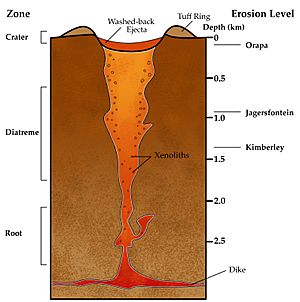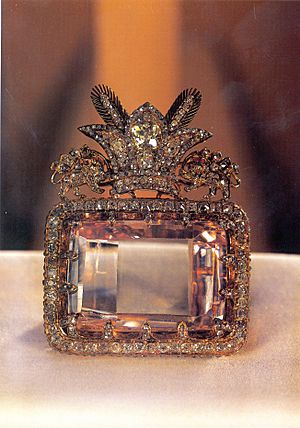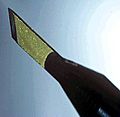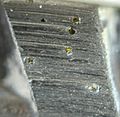Diamond facts for kids
Quick facts for kids Diamond |
|
|---|---|
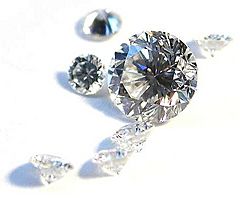
A scattering of round-brilliant cut diamonds shows off the many reflecting facets.
|
|
| General | |
| Category | minerals |
| Formula (repeating unit) |
C |
| Strunz classification | 01.CB.10a |
| Identification | |
| Formula mass | 12.01 g/mol |
| Color | Typically yellow, brown or gray to colorless. Less often blue, green, black, translucent white, pink, violet, orange, purple and red. |
| Crystal habit | Octahedral |
A diamond (from the ancient Greek αδάμας – adámas "unbreakable") is a re-arrangement of carbon atoms (those are called allotropes).
Diamonds have the highest hardness of any bulk (all one type) material. Because of this, many important industries use diamonds as tools for cutting and polishing things. Many of them are clear, but some of them have colors, like yellow, red, blue, green and pink. Diamonds of a different color are called "fancies".
Big diamonds are very rare, and are worth a lot of money. Only 20% of diamonds are fit for jewellery. The other 80% are of lower quality. Those lower quality diamonds are called industrial diamonds, and are used to make things like drill bits and diamond saws. Even if a diamond is not of gem quality, it still has a value because it is very hard.
Cut and faceted diamonds can be attractive hence their use in jewellery.
Diamonds are very effective electrical insulators, but also very good conductors of heat.
On Mohs scale of mineral hardness, diamonds are scored as 10 (the highest score possible).
Contents
Formation of diamonds
There are natural and synthetic diamonds. The Earth makes natural diamonds, and people make synthetic diamonds.
Diamonds are the hardest natural substance known to man. Diamonds are made of pure carbon, the same chemical element as graphite, fullerene, and coal. But diamonds are very hard and in crystalline form. It is commonly believed that diamonds are formed from coal, but this is not true.
Most natural diamonds have ages between 1 billion and 3.5 billion years. Most were formed at depths between 150 and 250 kilometres (93 and 155 mi) in the Earth's mantle, although a few have come from as deep as 800 kilometres (500 mi). Under high pressure and temperature, carbon-containing fluids dissolved various minerals and replaced them with diamonds. Much more recently (tens to hundreds of million years ago), they were carried to the surface in volcanic eruptions and deposited in igneous rocks known as kimberlites and lamproites.
Small synthetic diamonds are made for abrasives. Large synthetic ones are even more expensive to make than to find and dig up, so people don't make large synthetic diamonds.
Where to find diamonds
People find diamonds where volcanoes were a long time ago. They sometimes find tiny ones at the site of a meteorite strike. Sometimes people find diamonds on the top of the ground. But in places like South Africa, they must dig deep down into a diamond mine to get diamonds. Diamonds were first found in India.
Grading
The most familiar uses of diamonds today are as gemstones used for adornment, and as industrial abrasives for cutting hard materials. The markets for gem-grade and industrial-grade diamonds value diamonds differently.
In the 20th century, experts in gemology developed methods of grading diamonds and other gemstones based on the characteristics most important to their value as a gem. Four characteristics, known informally as the four Cs, are now commonly used as the basic descriptors of diamonds: these are its mass in carats (a carat being equal to 0.2 grams), cut (quality of the cut is graded according to proportions, symmetry and polish), color (how close to white or colorless; for fancy diamonds how intense is its hue), and clarity (how free is it from inclusions). A large, flawless diamond is known as a paragon.
Trading in diamonds
For many decades the trading of diamonds was controlled by the De Beers group of companies, who controlled most of Africa's rich diamond mines. However, in the late 1980s and early 1990s, new diamond mines opened in Canada and Australia that De Beers wasn't able to control. When the USSR collapsed in 1991, many cheap Russian diamonds entered the market, overwhelming De Beers and their efforts to control it. De Beers still runs most of Africa's diamond mines, but their mines now only produce about one third of the world's diamonds.
Diamond cutting
Mined rough diamonds are converted into gems through a multi-step process called "cutting". Diamonds are extremely hard, but also brittle and can be split up by a single blow. Therefore, diamond cutting is traditionally considered as a delicate procedure requiring skills, scientific knowledge, tools and experience. Its final goal is to produce a faceted jewel where the specific angles between the facets would optimize the diamond luster, that is dispersion of white light, whereas the number and area of facets would determine the weight of the final product.
Several possible shapes are considered. Some of them may be considered as classical, such as round, pear, marquise, oval, hearts and arrows diamonds, etc. Some of them are special, produced by certain companies, for example, Phoenix, Cushion, Sole Mio diamonds, etc.
Theft
Occasionally, large thefts of diamonds take place. In February 2013 armed robbers carried out a raid at Brussels Airport and escaped with gems estimated to be worth US$50M (£32M; €37M). The gang broke through a perimeter fence and raided the cargo hold of a Swiss-bound plane. The gang have since been arrested and large amounts of cash and diamonds recovered.
The identification of stolen diamonds presents a set of difficult problems. Rough diamonds will have a distinctive shape depending on whether their source is a mine or from an alluvial environment such as a beach or river—alluvial diamonds have smoother surfaces than those that have been mined. Determining the provenance of cut and polished stones is much more complex.
The Kimberley Process was developed to monitor the trade in rough diamonds and prevent their being used to fund violence. Before exporting, rough diamonds are certificated by the government of the country of origin. Some countries, such as Venezuela, are not party to the agreement. The Kimberley Process does not apply to local sales of rough diamonds within a country.
Diamonds may be etched by laser with marks invisible to the naked eye. Lazare Kaplan, a US-based company, developed this method. However, whatever is marked on a diamond can readily be removed.
Images for kids
-
Brown diamonds at the National Museum of Natural History in Washington, D.C.
-
The most famous colored diamond, the Hope Diamond
-
Eclogite with centimeter-size garnet crystals
-
A scalpel with synthetic diamond blade
-
Close-up photograph of an angle grinder blade with tiny diamonds shown embedded in the metal
-
A diamond knife blade used for cutting ultrathin sections (typically 70 to 350 nm) for transmission electron microscopy
-
Siberia's Udachnaya diamond mine
See also
 In Spanish: Diamante para niños
In Spanish: Diamante para niños


